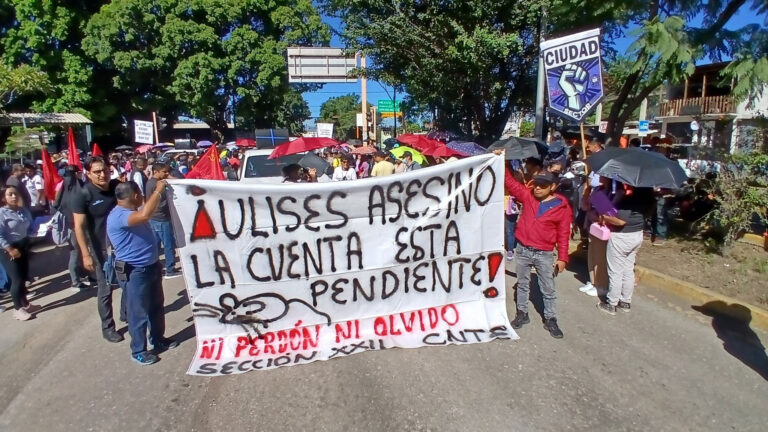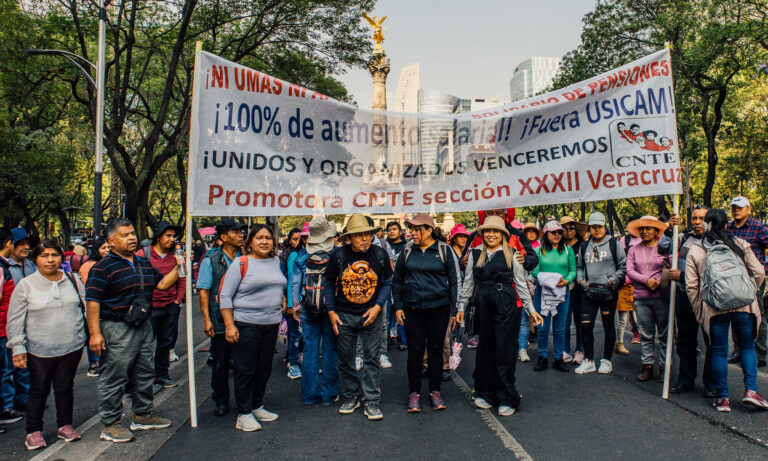CNTE TO CONTINUE MEXICO CITY MOBILIZATION
This article by Laura Poy and Alexia Villaseñor appeared in the June 4, 2025 edition of La Jornada, Mexico’s premier daily leftist newspaper.
What are the CNTE’s Demands?
Immediate repeal of the 2007 ISSSTE Law; restoration of a solidarity-based, collective, and intergenerational pension system; the full recognition of retirement based on years of service (28 for women and 30 for men) instead of the age of 65; the payment of pensions based on the minimum wage rather than on UMAs; the elimination of AFOREs as a privatization model (AFOREs are private companies who manage pensions as individual accounts, extremely restrictive and profitable for finance capital: they were introduced in 1997 and based on the privatized pensions introduced by Chilean fascist Pinochet); and a profound restructuring of ISSSTE to restore its social character.
The National Coordinator of Education Workers (CNTE) reiterated that it will maintain a united day of action and emphasized that any decision to maintain the national strike or to strategically withdraw the mobilized contingents must be agreed upon by the National Representative Assembly (ANR), the highest decision-making body of the dissident teachers’ union.
Following 20 days of protests in the nation’s capital and the establishment of a sit-in in the capital’s Zócalo since May 15, leaders of the coordinating body insisted that any pause in the struggle, in order to reorganize the movement for the repeal of the 2007 ISSSTE Law, must be unitary and after consultation with each contingent.
Following a new consultation with the mobilized teachers, Section 22 of Oaxaca agreed to continue the protest actions in Mexico City this Wednesday, when the Single National Negotiating Commission (CNUN) will again meet with the federal government at the Ministry of the Interior (SG).
The grassroots agreement is to continue our day of struggle in support of the CNUN, reiterate the demand for the repeal of the 2007 ISSSTE Law, as well as for a decisive meeting with President Claudia Sheinbaum Pardo and a clear agenda for the tripartite committees, emphasized one of the Oaxaca teacher leaders.
CNTE leaders indicated that, after concluding this day of analyzing the contingents, a new session of their national assembly was convened, but at press time, the meeting had not yet begun.
Protest, Rain and Respiratory Illnesses
Dissident teachers who remain at the Zócalo camp reported that, on average, between 150 and 200 educators seek medical care for respiratory or gastrointestinal problems.
In a tour conducted by La Jornada, a decrease in the presence of some contingents was noted, mainly from Oaxaca and Chiapas, although the arrival of some teachers was also observed, who relieve their colleagues.
Teachers from various states admitted that they’ve been sleeping on the ground for 20 days now, in the rain, the cold, and the heat. “It’s not that we’re feeling defeated, but fatigue is already building, and the number of our colleagues reporting discomfort is growing every day, especially after the rains that soaked us all.”
As has been the case since May 15, the web of cables and ropes supporting hundreds of tents has not prevented street vendors, passersby, office workers, and employees of nearby businesses from coexisting in a sea of plastic, which, like a multicolored roof, attempts to protect the protesters from the sun and rain.
Professor José, from the Mixteca region of Oaxaca, estimates that he spends up to 400 pesos a day to cover the cost of his food, bathrooms and showers, and drinking water. “It’s not easy being here; we don’t do it for fun. That’s why we’re even more concerned when we see the stubbornness of a government that refuses to recognize that we all deserve a decent pension.”
Who Owns the AFORES?
There are 10 AFORES, that as of 2025 manage more than 7.18 trillion pesos (401 Billion USD). The AFORES system, modeled on Chilean fascist dictator Pinochet’s privatization of pensions, have been criticized by international pension industry observers for lacking sufficient oversight. The Mexican government has cited the complexity of the system as a reason not to de-privatize it, which begs the question, if the pensions are too complex to return to the public, how can they be meaningfully overseen and regulated?
AFORES accounts are mandatory for every worker: they cannot withdraw from the system or manage the fund themselves or collectively with their union, such as with the Ontario Teachers’ Pension Plan, which manages over $188 billion USD).
1. AFORE Coppel – Coppel Group
2. AFORE Azteca – Grupo Salinas, owned by Ricardo Salinas Pliego, an ultra-right wing billionaire who is fighting in the courts to not pay the 35.450 billion pesos ($1.8 billion USD) in taxes he owes to the Mexican government.
3. Citibanamex Afore – Citigroup —in the process of being sold (USA)
4. Afore XXI-Banorte – Banorte
5. SURA – SURA Group (Colombia)
6. Profuturo – BAL Group (owners of the high-end department store El Palacio de Hierro)
7. Principal – Principal Financial Group (USA)
8. Invercap – Private investment fund
9. PensionISSSTE – The only public pension, limited to state workers
10. Inbursa – owned by Carlos Slim, one of the richest businessmen in the world, who recently advocated ending the public pension system and abolishing the retirement age in Mexico, and met with Claudia Sheinbaum last week.
-
CNTE Teachers Thwart Right Wing Party Assembly
Teachers from Valles Centrales disrupted a political event orchestrated for a new party being formed by ex-governor of Oaxaca Ulises Ruiz Ortiz , responsible for repression against teachers in 2006 which led to 20 murders & multiple disappearances.
-
CNTE Says Funding Agreed Upon with Government Hasn’t been Delivered
The teachers say bureaucratic procedures have delayed funding as well as computers and projectors for schools, which have been needed since AMLO’s term.
-
Analysis | Interviews | Labor
Morena Disappoints: Teachers Get No Security
An interview with Eligio Valdes, General Coordinator of CNTE Michoacan.




